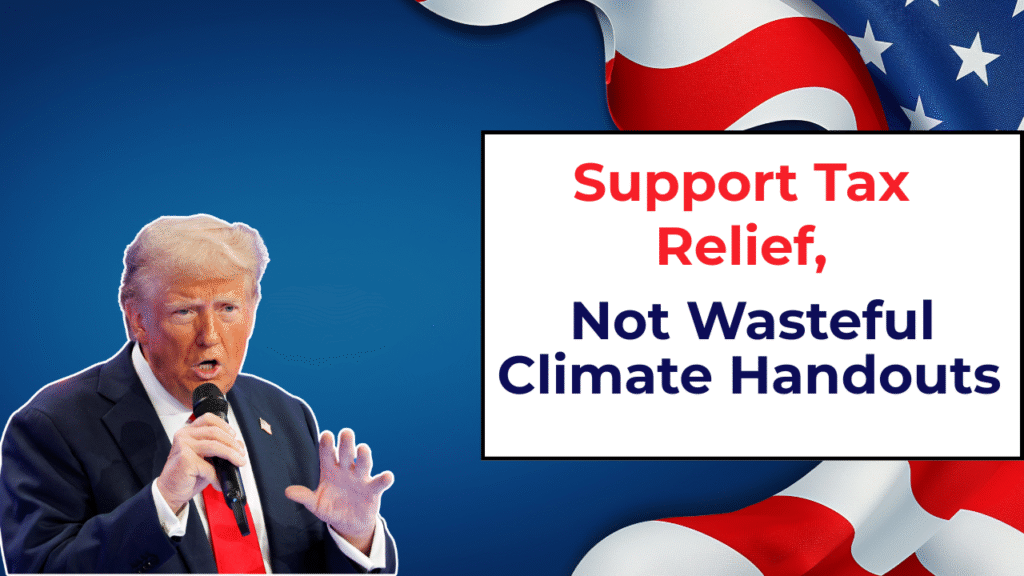Introduction
As America stares down another fiscal cliff, Congress faces a pivotal decision: what to do with the expiring provisions of the 2017 Tax Cuts and Jobs Act (TCJA), commonly known as the Trump tax cuts. These cuts, especially for individuals and small businesses, are set to expire at the end of 2025. Meanwhile, the Biden administration’s climate-related spending, largely enacted through the 2022 Inflation Reduction Act (IRA), has opened the floodgates for green subsidies and tax credits. At a time when the national debt exceeds $34 trillion, extending tax relief for working Americans should be a priority and it can be responsibly funded by rolling back unnecessary climate handouts.
The Expiring Tax Cuts
The TCJA, signed into law by President Donald Trump in December 2017, significantly reduced federal income tax rates, increased the standard deduction, and boosted the child tax credit. While corporate tax rate cuts were made permanent, individual tax provisions—including lower tax brackets and the increased child tax credit were made temporary, scheduled to sunset after 2025.
According to the Joint Committee on Taxation, extending the expiring individual provisions of the TCJA would cost approximately $4 trillion over ten years. However, these provisions have delivered measurable benefits to middle-class Americans and small businesses. Failure to extend them would amount to a tax hike on millions of households.
Biden’s Climate Spending
In contrast, the Biden administration’s climate agenda has introduced a range of subsidies and tax credits through the IRA, aiming to promote green energy and reduce carbon emissions. The White House has described these initiatives as essential for addressing climate change and driving clean energy innovation.
However, estimates from the Congressional Budget Office (CBO) and private-sector analyses suggest these climate-related provisions could cost significantly more than originally projected potentially upwards of $1.2 trillion over the next decade. This includes generous tax credits for electric vehicles, solar and wind energy, clean hydrogen, and other green technologies.
Many of these subsidies disproportionately benefit wealthy households and large corporations. For example, luxury electric vehicle buyers can receive tax credits of up to $7,500, while large energy firms stand to gain billions in subsidies for projects that may have proceeded without government support.
A Fiscal Trade-Off That Makes Sense

Extending the Trump tax cuts—particularly the middle-class provisions without adding to the deficit is a worthy goal. Doing so requires offsetting revenue, and rolling back or scaling down Biden’s climate subsidies is a logical source.
This approach serves two purposes. First, it ensures continued tax relief for average Americans who are grappling with inflation and economic uncertainty. Second, it reins in an expensive and often inefficient set of programs that have been criticized even by some environmentalists for lacking cost-effectiveness and transparency.
A growing body of evidence suggests that market-driven clean energy growth can proceed without excessive government intervention. According to the U.S. Energy Information Administration (EIA), the cost of solar and wind technologies has fallen sharply over the past decade, making them increasingly competitive without subsidies.
Moreover, the government’s track record in managing industrial policy and picking winners has often resulted in wasteful spending and limited returns. Rather than doubling down on questionable green investments, policymakers should focus on tax policies that promote broad-based economic growth.
Political and Economic Implications
As the 2024 election cycle unfolds, tax policy and climate spending are set to be key battlegrounds. Republicans are likely to campaign on making the Trump tax cuts permanent, while Democrats will defend the climate provisions of the IRA as vital investments in America’s future.
However, public opinion remains mixed. Polling suggests that while many Americans support clean energy in principle, they are wary of high costs and government overreach. On the other hand, tax cuts especially for the middle class remain broadly popular.
Economically, extending tax cuts could provide a stabilizing force amid concerns about slowing growth and rising interest rates. By contrast, pouring more federal dollars into climate subsidies may deliver diminishing returns and exacerbate inflationary pressures.
A Prudent Path Forward
Lawmakers should prioritize what directly benefits the majority of Americans: lower taxes, higher take-home pay, and economic certainty. Extending the TCJA’s individual provisions is one of the most effective ways to achieve this.
At the same time, it’s fiscally irresponsible to ignore the cost of these extensions. The solution lies not in raising other taxes or adding to the national debt, but in eliminating or significantly scaling back climate handouts that have ballooned beyond their original scope.
This is not about abandoning climate goals; it’s about achieving them more efficiently. Private investment, technological innovation, and state-level initiatives can all play a role in reducing emissions without relying on massive federal subsidies.
Conclusion
Extending the Trump-era tax cuts is crucial for working families and the broader economy. But to do so without increasing the national debt, Congress must make tough choices and repealing or reforming the Biden administration’s costly climate provisions is a sensible start.
Rather than subsidizing industries and consumers who often don’t need the help, the federal government should prioritize policies that foster economic resilience and reduce the tax burden on everyday Americans. This is a trade-off that reflects both fiscal responsibility and political pragmatism.

